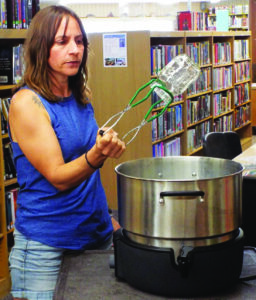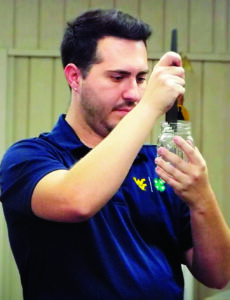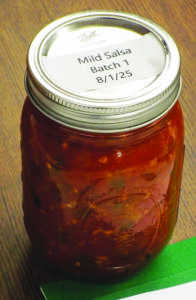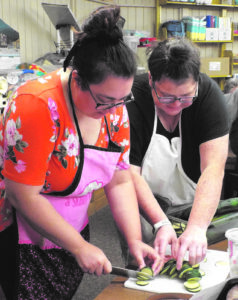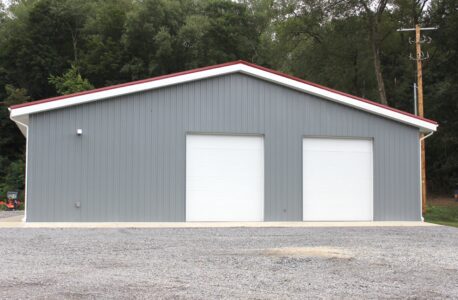Chester residents learn the art of canning
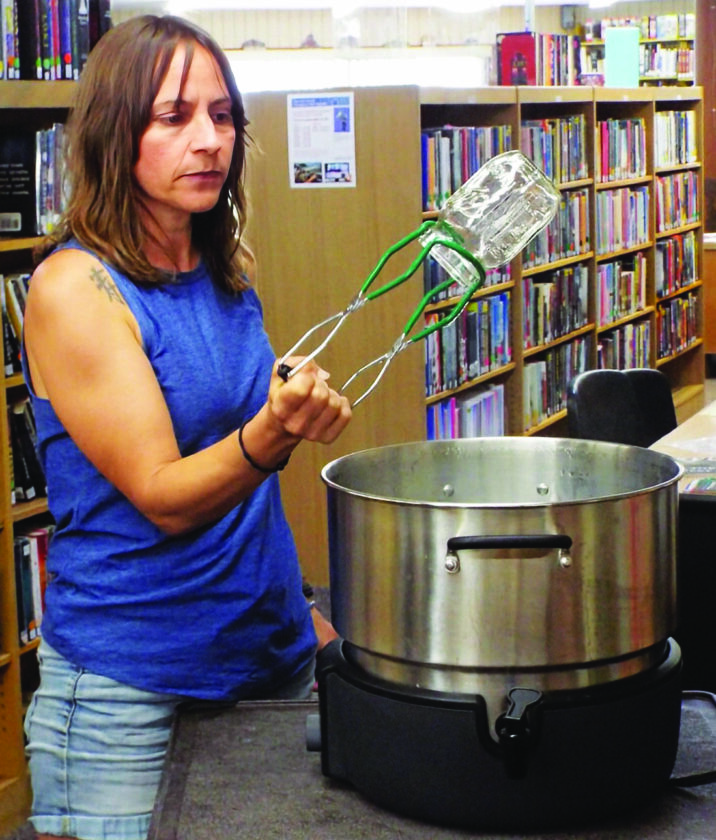
Arwen Niles, of Chester, pulls her jar of pickle slices from a water bath using a jar lifter Tuesday afternoon during a canning class at Lynn Murray Memorial Library in Chester. (Photo by Stephanie Ujhelyi)
- Arwen Niles, of Chester, pulls her jar of pickle slices from a water bath using a jar lifter Tuesday afternoon during a canning class at Lynn Murray Memorial Library in Chester. (Photo by Stephanie Ujhelyi)
- WVU Extension agent Zach White shows a dozen local homemakers how to utilize a headspace tool, while instructing a class Tuesday afternoon on canning at Lynn Murray Memorial Library in Chester. The proper measurements is to leave a quarter-inch of headspace between the top of the jar and a jam or jelly or a half-inch of headspace room for fruits and vegetables. His class was teaching how to mark pickles, so it was a half-inch. Another follow-up class on making jellies is in the works. (Photo by Stephanie Ujhelyi)
- This jar of salsa was prepared previously and brought by the WVU Extension instructor to the class, so students could learn how to distinguish a properly sealed jar from one with a false seal. The canning class was held Tuesday afternoon at Lynn Murray Memorial Library in Chester. (Photo by Stephanie Ujhelyi)
- From left, Zach White, WVU Hancock County Extension agent, instructs a dozen area homemakers on proper canning procedures during a Tuesday class at Lynn Murray Memorial Library in Chester before leading them in making pickles using the water bath method. Plans are for a future class to teach them how to make jellies and jams.
- At left, Marie Cenname cuts a cucumber with help from Allison White Tuesday afternoon during a class teaching a dozen local homemakers how to prepare and process pickle slices using the water bath method of canning. Both women are from East Liverpool. (Photo by Stephanie Ujhelyi)
On Tuesday afternoon, the library was the site of a canning class offered by the WVU Hancock County Extension office that detailed the fine art of canning via water bath.
The class is a favorite of instructor Zach White, who explained, “Home food preservation is not only a great way to enjoy your garden harvest all year long, but it also helps reduce food waste and ensures you know exactly what’s in the food you’re serving your family.”
Twelve people from West Virginia, Ohio and Pennsylvania attended and turned to cucumbers into pickles through the canning process using the boiling water bath method.
Participants learned proper water bath canning procedures, safe food preparation and each were able to take home the pint jar of pickle slices canned in class.
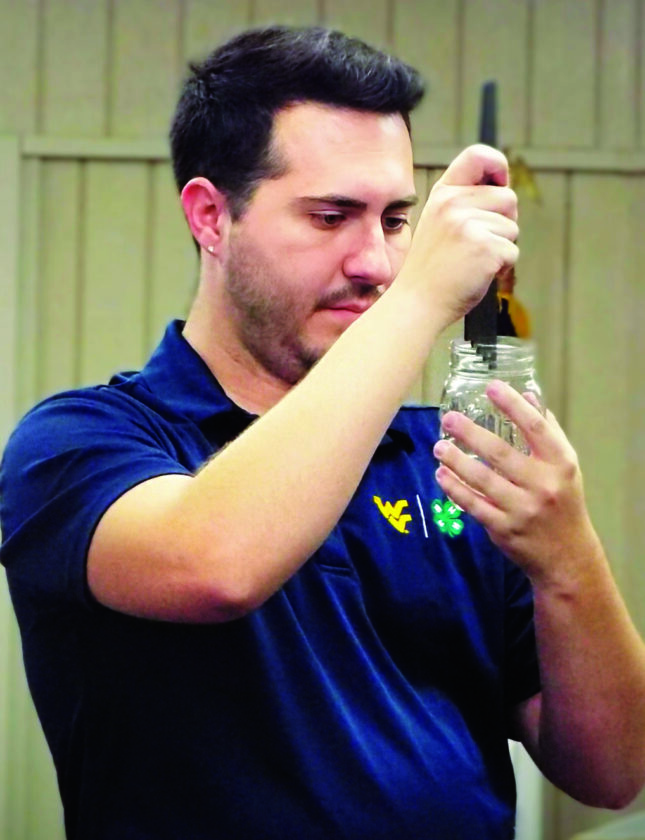
WVU Extension agent Zach White shows a dozen local homemakers how to utilize a headspace tool, while instructing a class Tuesday afternoon on canning at Lynn Murray Memorial Library in Chester. The proper measurements is to leave a quarter-inch of headspace between the top of the jar and a jam or jelly or a half-inch of headspace room for fruits and vegetables. His class was teaching how to mark pickles, so it was a half-inch. Another follow-up class on making jellies is in the works. (Photo by Stephanie Ujhelyi)
White explained that although high-acid foods, such as tomatoes, can be canned in boiling water like the pickles, as one adds brine to the cucumber slices in the jar, low acid vegetables and products such as beef stew must be canned in a pressure canner.
Altitude also does play a role in your canning time, so he urged attendees to add extra time as Chester is 1,000 feet above sea level.
Jars should be cleaned in soapy water and kept hot before use to avoid breakage when they are filled with a hot product before being returned to the canner (once filled) for processing.
Any jars with nicks, cracks or rough edges should be discarded as they compromise the airtight seal, allowing food to spoil, White explained.
In the case of pressure canners, the extension agent discouraged use of pressure cookers as pressure canners, as they are not the same. “Canning can be a scary thing especially with pressure canning,” White said.
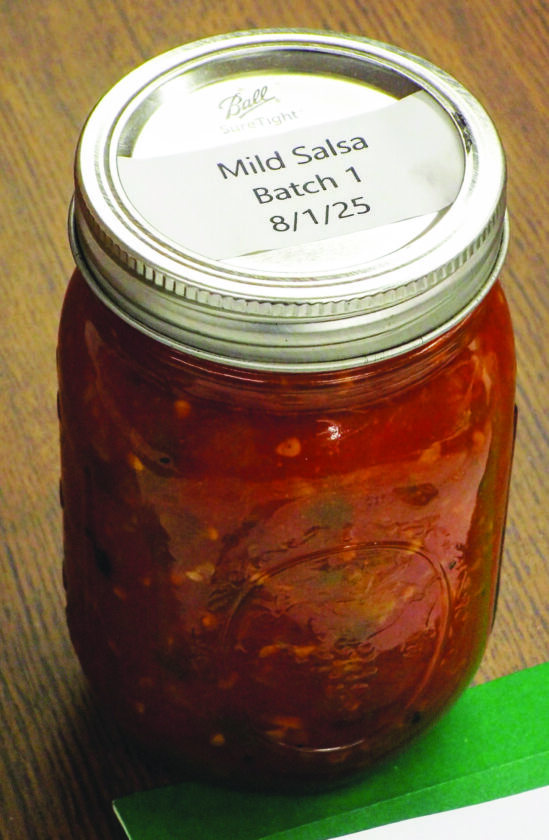
This jar of salsa was prepared previously and brought by the WVU Extension instructor to the class, so students could learn how to distinguish a properly sealed jar from one with a false seal. The canning class was held Tuesday afternoon at Lynn Murray Memorial Library in Chester. (Photo by Stephanie Ujhelyi)
Larger than pressure cookers, pressure canners can hold more jars plus reach a higher PSI (pressur per square inch) than cookers to ensure the user is meeting safety guidelines associated with United States Department of Agriculture recipes.
Following directions when canning is key to allow for proper processing, explained White. “You can add time if needed but not take away.”
Some participants expressed concerns about their past canning habits upon learning the new information from White.
He also discussed the types of packing jars as part of the preparation. On Tuesday, participants utilized raw packing, slicing the cucumbers and inserting the raw vegetables into the canning jar before pouring in the hot brine liquid, allowing the appropriate half-inch of head room near the top (It is a quarter-inch for most jams and jellies) and screwing the lid on fingertip tight.
With hot packing, the food is cooked inserted in the jar and then the cooking liquid is poured in.
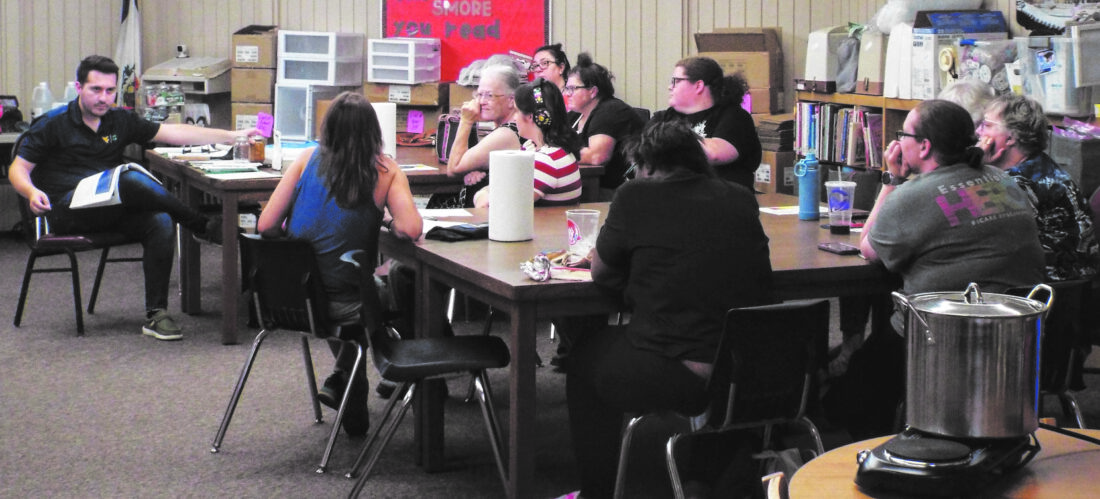
From left, Zach White, WVU Hancock County Extension agent, instructs a dozen area homemakers on proper canning procedures during a Tuesday class at Lynn Murray Memorial Library in Chester before leading them in making pickles using the water bath method. Plans are for a future class to teach them how to make jellies and jams.
Jars need to be fully submerged in your cooking vessel with water to be properly processed.
Due to the popularity of Tuesday’s class, another session is pending at the library regarding the canning of jams and jellies. That date and time will be announced when set.
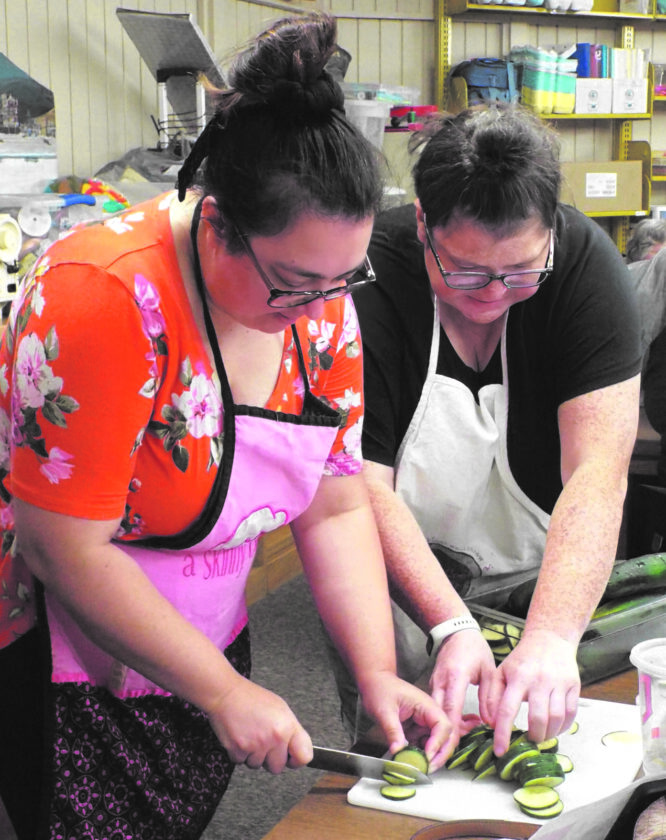
At left, Marie Cenname cuts a cucumber with help from Allison White Tuesday afternoon during a class teaching a dozen local homemakers how to prepare and process pickle slices using the water bath method of canning. Both women are from East Liverpool. (Photo by Stephanie Ujhelyi)

